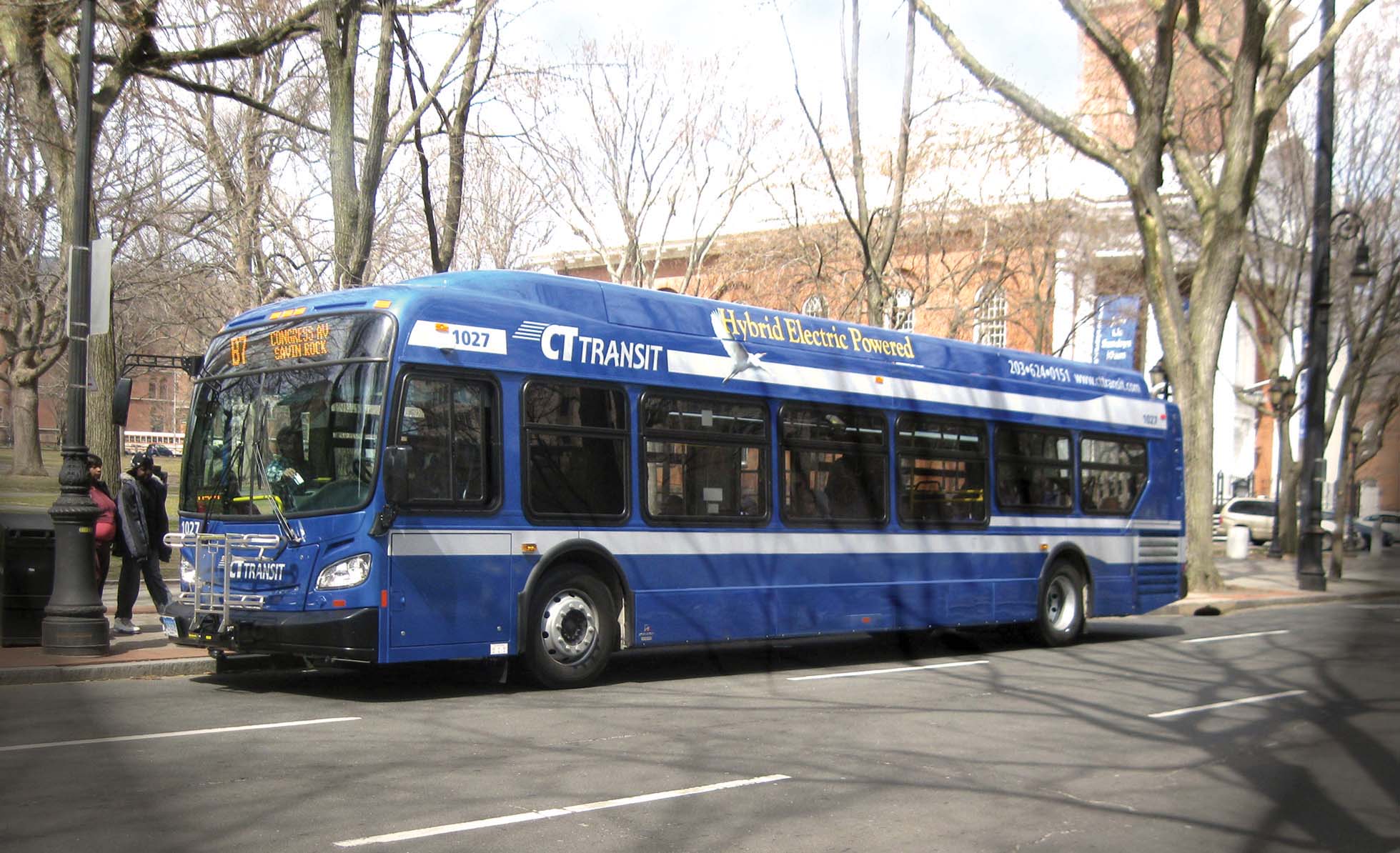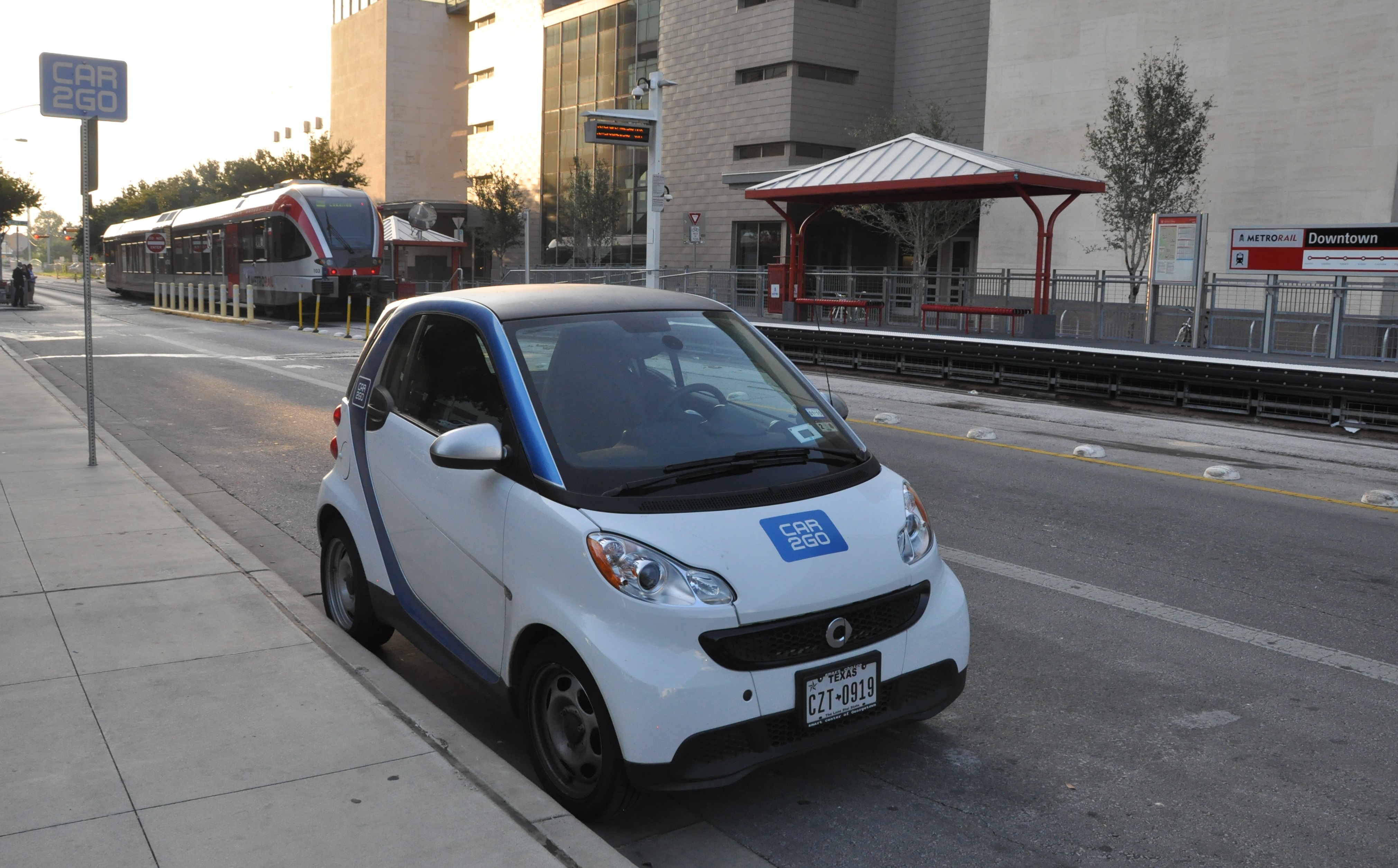Connecticut champions open government and open data to help fostertransparency, accountability and citizen engagement – and that includes transportation matters as Andrew Bardin Williams discovers. The last thing anyone wanted was to inconvenience or displace others - least of all people who lived and worked in the neighbourhood. Yet, workers in an office building in downtown New Haven, Conn., were tired of shuffling through hoards of people who kept sitting on the stoop to the building while waiting for th

CTTransit is using other methods of lowering emissions and CO2 such as hybrid buses
RSSConnecticut champions open government and open data to help fostertransparency, accountability and citizen engagement – and that includes transportation matters as Andrew Bardin Williams discovers.
The last thing anyone wanted was to inconvenience or displace others - least of all people who lived and worked in the neighbourhood. Yet, workers in an office building in downtown New Haven, Conn., were tired of shuffling through hoards of people who kept sitting on the stoop to the building while waiting for the bus, and they couldn’t exactly open the door on people or shove them out of the way.
The stop at the corner of Chapel and State Streets is a busy and important one, connecting downtown to a working-class neighbourhood a few miles away. During business hours and especially during the morning and afternoon commutes, dozens of people wait for the public transit system - many with their head down, scrolling through their phone or chatting away with their fellow riders. On hot days people sat on the stoop in the shade of the adjacent office building, and they huddled under the overhang on rainy or snowy days, blocking the entrance.
A solution needed to be found, so the building’s management company posted on7785 SeeClickFix, a website that allows citizens to report non-emergency issues such as potholes, broken streetlights and graffiti. Other people in the community commented on the
post, suggesting various solutions - but HERE is where the story takes a turn from typical complaints about public services. The government actually responded and chimed in. The city’s Department of Parking and Traffic took interest as did the New Haven Safe Streets Coalition, a group of elected officials, city workers and concerned citizens. Both organisations posted proposed solutions in the thread.
Eventually7756 Connecticut Transit (CTTransit), the state’s public transit agency, responded to the community’s request to install a bench and shelter at the stop, giving riders a safe place to rest and get out of the elements. Immediately, the area around nearby storefronts and the stoop leading into the office building cleared up, and workers and shoppers could come and go without displacing anyone huddled around the front door.
It can seem rare in today’s hyper-charged political environment, but here is an example of government actually working for the people it is meant to serve. A problem was identified by citizens, solutions were proposed by local officials and a fix was put in place by a state agency. In the process, a place was created - a place where people had banded together to solve an issue. Today, the area bus stop is one of the cleanest in the city, usually free from the trash and graffiti that litter other stops - in no small part due to the community’s sense of ownership and pride over the stop.
“The public needs to have access to transportation information and have a say in how money is spent; simply for the fact that taxpayers are funding it,” said Holly Parker, director of sustainable transportation systems at Yale University.
Fortunately, the state of Connecticut agrees. The state’s Comptroller, Kevin Lembo has been a champion of open government since taking office in 2011. In an effort to make the state government more transparent and accountable, Lembo launched Open Connecticut, an online portal that provides media, academics, researchers and citizens access to state budgetary information. The entire budget is online, providing transparency into how the state is collecting and spending tax dollars, grants and outside funding.
“We always want to make sure we are starting with facts when we have these conversations about using state funding wisely, and making them freely available on the Open Connecticut website makes it possible to do that. There’s no confusion,” Lembo said.
Currently, the website is a simple aggregation of the state’s financial information which is explained in layman’s terms. Soon and thanks to an executive order by Governor Dannel Malloy, the portal will include payment information, documenting the money the state is paying to individuals, companies and organisations. Data will be updated in near real time, and the public will be able to drill down by agency or vendor, seeing how much the state is paying for specific products and services.
Open Connecticut includes transportation information, of course, highlighting budgetary data for highway construction, road repair, public transit, headcount and other transportation expenditures. According to Lembo, the drive to make transportation funding more transparent will help the state be more responsive to transportation needs and help it develop and build infrastructure more efficiently. And while Lembo doesn’t expect Joe Public to pour over the statistics on the website, he wants to make sure that the media, academics and advocates are using the information to educate citizens.
That’s where Parker and her Department of Sustainable Transportation at Yale come in. The department’s goal is to promote public transit and sustainable transit (walking, cycling, car share, etc.) throughout the Yale community and beyond, and it helps to have access to ridership studies, surveys and other transportation information at the staff’s fingertips. One thing that Parker continues to stress with her constituents is that driving actually costs taxpayers more than public transit--a fact that many Connecticutians do not realise.
“The perception is that taxpayers are subsidizing buses and trains for the poor, but they’re actually subsidising driving on a much greater scale,” she said. “I’m sick of the argument that people are paying for something they never use. They can use it, they should use it and they can save a lot of money.” The fact that Parker can cite funding statistics and per capita ridership studies makes her argument that much more powerful.
The state’s transit agencies are also using open data and open government to engage with riders. CTTransit, a public/private partnership that provides bus services throughout the state and between three metropolitan regions (Hartford, New Haven and Stamford), provides 27 million rides per year, and like any public transit system, buses aren’t always on schedule. Gretchen Gregg, a marketing administrator with CTTransit, uses a number of tools to update the public on delays, route changes and other transit information. She has an opt-in listserv, but she also uses Facebook and Twitter to get the word to riders as timely as possible.
Recently, she’s been using SeeClickFix, the issue reporting tool mentioned earlier in this article. The app lets her push notifications to riders who use the service which can reach them quicker than email and social media. She also uses the app to identify potential detours due to construction or special events and funnel that information to drivers and dispatchers who can reroute buses around the issues. She can then use the same platform to inform riders of the schedule and route changes.
Eventually, Gregg would like to use SeeClickFix to allow riders to report issues with vehicles, traffic violations committed by drivers and other safety concerns and route those issues to the agency’s existing customer service system. The app would let CTTransit acknowledge and resolve the issues quicker and more efficiently - resulting in better customer service and a higher-quality riding experience.
Transparency into transportation funding, policies and initiatives encourages the public to have trust in government and gives them ownership of local transportation issues. The result is better, more efficient governance and a progressive transportation strategy that meets the needs of the state’s residents.RSS
The last thing anyone wanted was to inconvenience or displace others - least of all people who lived and worked in the neighbourhood. Yet, workers in an office building in downtown New Haven, Conn., were tired of shuffling through hoards of people who kept sitting on the stoop to the building while waiting for the bus, and they couldn’t exactly open the door on people or shove them out of the way.
The stop at the corner of Chapel and State Streets is a busy and important one, connecting downtown to a working-class neighbourhood a few miles away. During business hours and especially during the morning and afternoon commutes, dozens of people wait for the public transit system - many with their head down, scrolling through their phone or chatting away with their fellow riders. On hot days people sat on the stoop in the shade of the adjacent office building, and they huddled under the overhang on rainy or snowy days, blocking the entrance.
A solution needed to be found, so the building’s management company posted on
post, suggesting various solutions - but HERE is where the story takes a turn from typical complaints about public services. The government actually responded and chimed in. The city’s Department of Parking and Traffic took interest as did the New Haven Safe Streets Coalition, a group of elected officials, city workers and concerned citizens. Both organisations posted proposed solutions in the thread.
Eventually
It can seem rare in today’s hyper-charged political environment, but here is an example of government actually working for the people it is meant to serve. A problem was identified by citizens, solutions were proposed by local officials and a fix was put in place by a state agency. In the process, a place was created - a place where people had banded together to solve an issue. Today, the area bus stop is one of the cleanest in the city, usually free from the trash and graffiti that litter other stops - in no small part due to the community’s sense of ownership and pride over the stop.
The power of open government
Open government initiatives in the state of Connecticut made this scenario possible. Government agencies use issue reporting tools like SeeClickFix to engage with citizens, and pertinent transportation information such as ridership statistics, economic development studies and public transit budgets are readily available for public consumption. States like Connecticut are embracing open government policies as a way to engage with citizens to better serve transportation needs in the state. In addition to giving citizens a say in local transportation policy, these initiatives ensure transparency and accountability, providing a boost of confidence in state agencies at a time when public trust in government is at an all-time low.“The public needs to have access to transportation information and have a say in how money is spent; simply for the fact that taxpayers are funding it,” said Holly Parker, director of sustainable transportation systems at Yale University.
Fortunately, the state of Connecticut agrees. The state’s Comptroller, Kevin Lembo has been a champion of open government since taking office in 2011. In an effort to make the state government more transparent and accountable, Lembo launched Open Connecticut, an online portal that provides media, academics, researchers and citizens access to state budgetary information. The entire budget is online, providing transparency into how the state is collecting and spending tax dollars, grants and outside funding.
“We always want to make sure we are starting with facts when we have these conversations about using state funding wisely, and making them freely available on the Open Connecticut website makes it possible to do that. There’s no confusion,” Lembo said.
Currently, the website is a simple aggregation of the state’s financial information which is explained in layman’s terms. Soon and thanks to an executive order by Governor Dannel Malloy, the portal will include payment information, documenting the money the state is paying to individuals, companies and organisations. Data will be updated in near real time, and the public will be able to drill down by agency or vendor, seeing how much the state is paying for specific products and services.
Open Connecticut includes transportation information, of course, highlighting budgetary data for highway construction, road repair, public transit, headcount and other transportation expenditures. According to Lembo, the drive to make transportation funding more transparent will help the state be more responsive to transportation needs and help it develop and build infrastructure more efficiently. And while Lembo doesn’t expect Joe Public to pour over the statistics on the website, he wants to make sure that the media, academics and advocates are using the information to educate citizens.
That’s where Parker and her Department of Sustainable Transportation at Yale come in. The department’s goal is to promote public transit and sustainable transit (walking, cycling, car share, etc.) throughout the Yale community and beyond, and it helps to have access to ridership studies, surveys and other transportation information at the staff’s fingertips. One thing that Parker continues to stress with her constituents is that driving actually costs taxpayers more than public transit--a fact that many Connecticutians do not realise.
“The perception is that taxpayers are subsidizing buses and trains for the poor, but they’re actually subsidising driving on a much greater scale,” she said. “I’m sick of the argument that people are paying for something they never use. They can use it, they should use it and they can save a lot of money.” The fact that Parker can cite funding statistics and per capita ridership studies makes her argument that much more powerful.
Fairness in government
Open Connecticut also challenges private contractors to be more transparent as well. While some aspects of the bidding process are kept private due to intellectual property concerns, nearly 90% of bidding on transportation projects is completely open for public scrutiny, according to Connecticut Department of Transportation spokesperson Kevin Nursick. This ensures fairness in the bid process (the qualified contractor with the lowest bid gets the project), ensuring objectivity while quelling any perceptions of favouritism. This information is readily accessible on the DOT’s website and with the Department of Administrative Services.The state’s transit agencies are also using open data and open government to engage with riders. CTTransit, a public/private partnership that provides bus services throughout the state and between three metropolitan regions (Hartford, New Haven and Stamford), provides 27 million rides per year, and like any public transit system, buses aren’t always on schedule. Gretchen Gregg, a marketing administrator with CTTransit, uses a number of tools to update the public on delays, route changes and other transit information. She has an opt-in listserv, but she also uses Facebook and Twitter to get the word to riders as timely as possible.
Recently, she’s been using SeeClickFix, the issue reporting tool mentioned earlier in this article. The app lets her push notifications to riders who use the service which can reach them quicker than email and social media. She also uses the app to identify potential detours due to construction or special events and funnel that information to drivers and dispatchers who can reroute buses around the issues. She can then use the same platform to inform riders of the schedule and route changes.
Eventually, Gregg would like to use SeeClickFix to allow riders to report issues with vehicles, traffic violations committed by drivers and other safety concerns and route those issues to the agency’s existing customer service system. The app would let CTTransit acknowledge and resolve the issues quicker and more efficiently - resulting in better customer service and a higher-quality riding experience.
Transparency into transportation funding, policies and initiatives encourages the public to have trust in government and gives them ownership of local transportation issues. The result is better, more efficient governance and a progressive transportation strategy that meets the needs of the state’s residents.RSS











